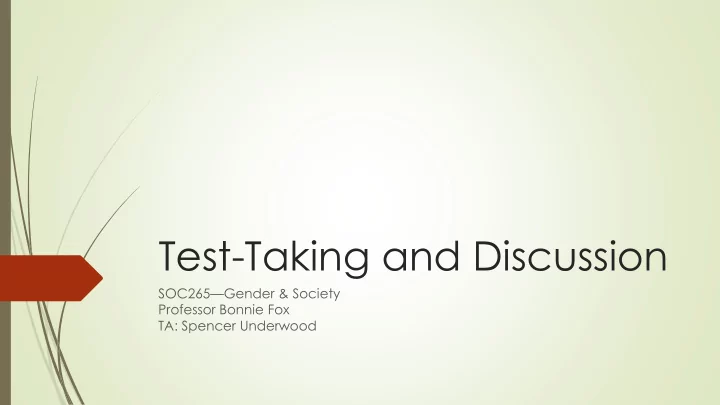

Test-Taking and Discussion SOC265 — Gender & Society Professor Bonnie Fox TA: Spencer Underwood
Outline 1. Taking Tests Multiple Choice • Essays • 2. Discussion Study practice and test prep •
Test-Taking: Multiple Choice • A, B, C, D answers can all be correct in general, but choose the most correct response to the question, according to course materials • Eliminate any incorrect answers • Always pick a MC answer, even if you need to guess. • If the MC question is an EXCEPT question, look for the one wrong answer -- the statement that is not true.
Example Question According to Thomas Laqueur , the “two - sex” model of the sexed (male or female) body developed because… (a) the idea of naturally different male and female bodies was a useful explanation of gender inequality. (b) scientists discovered the different roles eggs and sperm play in biological reproduction. (c) the one-sex model was challenged in popular revolutions occurring in the late 1700s. (d) it reflected the gender inequality in European history better than the one-sex model.
Example Question In “Dude, You’re a Fag,” C.J. Pascoe argues that the use of the “fag” epithet by some boys was common in the high school she studied for all of the following reasons EXCEPT : (a) Boys in high school do not have a solid and stable masculine identity . (b) Calling another boy “fag” disciplined him for acting insufficiently masculine. (c) Masculinity takes its meaning in opposition to femininity, and for these boys homosexuality entailed slightly feminine masculinity. (d) Hatred of boys who practiced same-sex sex was widespread among these boys.
Test-Taking: Essays Read questions carefully. Ask if you have questions about them. • For essays, allocate time according to how much each question • weighs. Outline essays before writing. • Your answers should develop an argument. Try to first answer the • question in a single sentence, then build support for your answer by using relevant course materials. Do not just list facts or details. Only use them to support an overall point. • Write only on the test paper. • You must use course materials, including readings and lectures. It is • best if you can say “According to [author]…”
Example Essay Questions Describe two social processes that have worked to create the sex (Male/Female) binary. Explain how each process you describe worked or works to create the binary. Explain Lorber’s argument that “believing is seeing.” Describe two major ways institutions construct two distinct, exclusive genders.
Discussion Questions 1. These readings address the issue of biology. According to anthropologist Emily Martin, how do assumptions about gender shape biologists’ explanations of the process of reproduction? (While reading, do not worry about remembering the details of the biology!) 2. Psychologist Cordelia Fine reviews scientific research to address popular arguments that biology determines behaviour, especially the assumption that boys’ and girls’ brains are different and this brain difference makes their behaviour different. She also asks whether men and women are indeed different. What does she argue? 3. Neurobiologist Robert Sapolsky examines the evidence on whether the hormone testosterone causes aggressive behaviour in men. Does it? (Or, what does his evidence show?)
Discussion Questions 1. In the preschool she studied, Karin Martin found the girls being treated differently than the boys – specifically, that they were given different messages about how to manage their bodies. What were these different messages? What do we mean by “gendered bodies”? 2. Patricia Gagne and her colleagues have studied the costs that transgender people pay because of the male-female binary in this culture. What are the costs? 3. What did Emily Kane learn about how American parents react to nonconforming behaviour by their sons? 4. What does Judith Lorber’s title mean? What does Lorber argue about how gender is socially constructed (in sports and in the construction of public washrooms)?
Discussion Questions These readings provide an approach to understanding gender, especially how it is created – an understanding that challenges the assumption that gender is a stable characteristic of individuals. What is gender and how is it created, according to C. West and D. Zimmerman? The readings by Pascoe, Miller and Cooper provide examples of the “doing” of gender. What is C.J. Pascoe’s interpretation of the white boys’ frequent use of “fag” in the high school she studied? Marianne Cooper describes how a “new masculinity” is “done” by the men in Silicon Valley. What does this masculinity involve, and in what way is it a reflection of the particular industry the men are working in? Gillian Creese describes the challenges that young African immigrants face as they try to make a life in Vancouver. The task of presenting oneself in a way that avoids social sanction, which is a key concern in the West and Zimmerman argument, involves what challenges for these immigrants?
Recommend
More recommend